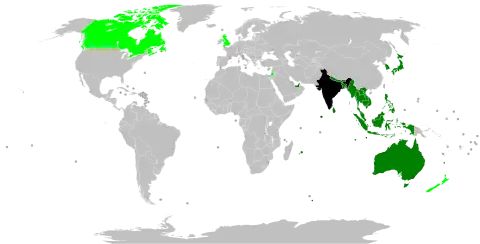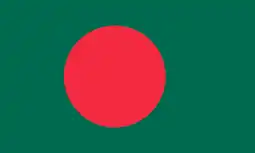Free trade agreements of India
India is party to free trade agreements (FTAs) and other trade agreements with many countries and trade blocs, and is negotiating with many others. As of 2022, India has preferential access, economic cooperation and FTA with more than 50 individual countries.
The negotiations for the Comprehensive Economic Partnership Agreement between India and the United Arab Emirates were completed in 88 days, which was the shortest time span for any free trade agreement signed by India.[1]
Overview

There are different types of trade agreements that enable preferential market access between India and signatory countries or trade blocs - preferential trade agreements (PTA), free trade agreements (FTA), and Comprehensive Economic Cooperation Agreements (CECA) and Comprehensive Economic Partnership Agreements (CEPA).[2]
A preferential trade agreement (PTA) involves two or more partners agreeing to reduce tariffs on an agreed number of tariff lines (products). The list of products on which the partners agree to reduce duty is called the positive list. In general, PTAs do not cover substantially all trade. The India Mercosur Preferential Trade Agreement is an example of a PTA.[2]
A free trade agreement (FTA) also involves reducing or eliminating tariffs on items traded between the partner countries; however each maintains individual tariff structure for non-members. The key difference between an FTA and a PTA is that PTAs have a positive list of products on which duty is to be reduced, while an FTA uses a negative list on which duty is not reduced or eliminated. Thus, compared to a PTA, FTAs are generally more ambitious in coverage of tariff lines on which duty is to be reduced. The India Sri Lanka Free Trade Agreement is an example of an FTA.[2]
Comprehensive Economic Cooperation Agreement (CECA) and Comprehensive Economic Partnership Agreement (CEPA) are agreements which consist of an integrated package on goods, services and investment, as well as trade facilitation and rule-making in areas such as intellectual property, government procurement, technical standards and sanitary and phytosanitary issues. The India Korea CEPA is one such example and it covers a broad range of other areas such trade facilitation, customs cooperation, investment, competition, intellectual property rights etc. CECA/CEPAs are more comprehensive and ambitious than FTAs in terms of coverage of areas and the type of commitments. While a traditional FTA focuses mainly on goods, a CECA/CEPA provides holistic coverage of many areas like services, investment, competition, government procurement, disputes etc. Further, a CECA/CEPA looks deeper into the regulatory aspects of trade than an FTA. Due to this, it encompasses mutual recognition agreements (MRAs) that cover the regulatory regimes of the partners. An MRA recognises different regulatory regimes of partners on the presumption that they achieve the same end objectives.[2]
Bilateral agreements
| Country | Agreement name | Type | Signed | Effective | Ref. |
|---|---|---|---|---|---|
| India Afghanistan Preferential Trade Agreement | PTA | 6 March 2003 | 13 May 2003 | [3][4] | |
| Australia–India Comprehensive Economic Cooperation Agreement (AI-CECA) | CECA | 2 April 2022 | 29 December 2022 | [5][6] | |
| India Chile Preferential Trade Agreement | PTA | 8 March 2006 | 11 September 2007 | [7][8] | |
| Japan India Comprehensive Economic Partnership Agreement (JICEPA) | CEPA | 16 February 2011 | 1 August 2011 | [7] | |
| India Malaysia Comprehensive Economic Cooperation Agreement (IMCECA) | CECA | 8 February 2011 | 1 July 2011 | [7] | |
| India Mauritius Comprehensive Economic Cooperation and Partnership Agreement | CECPA | 22 February 2021 | 1 April 2021 | [7] | |
| India Thailand Free Trade Agreement | FTA | 9 October 2003 | 1 September 2006 | [7] | |
| India Singapore Comprehensive Economic Cooperation Agreement | CECA | 29 June 2005 | 1 August 2005 | [7] | |
| India Korea Comprehensive Economic Partnership Agreement (IKCEPA) | CEPA | 7 August 2009 | 1 January 2010 | [7] | |
| India Sri Lanka Free Trade Agreement (ISFTA) | FTA | 28 December 1998 | 1 March 2000 | [9] | |
| India UAE Comprehensive Economic Partnership Agreement | CEPA | 18 February 2022 | 1 May 2022 | [10][11] |
Under negotiation
 Bangladesh (CEPA)[7]
Bangladesh (CEPA)[7].svg.png.webp) Canada (CEPA)[12]
Canada (CEPA)[12] Israel (FTA)[7]
Israel (FTA)[7] New Zealand (FTA)[13]
New Zealand (FTA)[13] Peru (FTA)[7]
Peru (FTA)[7] United Kingdom (FTA)[14]
United Kingdom (FTA)[14]
Multilateral agreements
| Agreement name | Type | Countries/Trading Bloc | Signed | Effective | Ref. |
|---|---|---|---|---|---|
| Asia-Pacific Trade Agreement (APTA) | PTA | Bangladesh, China, Laos, Mongolia, South Korea, Sri Lanka | 1975 | ||
| ASEAN-India Trade in Goods Agreement | CECA | 13 August 2009 | 1 January 2010 | [7] | |
| ASEAN-India Trade in Services Agreement | November 2014 | 1 July 2015 | [7][17] | ||
| ASEAN-India Investment Agreement | November 2014 | 1 July 2015 | [7][17] | ||
| Global System of Trade Preferences (GSTP) | PTA | 41 countries | 13 April 1988 | 19 April 1989 | |
| India Mercosur Preferential Trade Agreement | PTA | 25 January 2004 | 1 June 2009 | [7] | |
| South Asia Free Trade Agreement (SAFTA) | FTA | South Asian Association for Regional Cooperation (SAARC) | 6 January 2004 | 1 January 2006 |
Under negotiation
- BIMSTEC (FTA)[13]
- European Union (FTA)[18]
- Gulf Cooperation Council (FTA)[19]
- IBSA (FTA)[13]
- Southern African Customs Union (South Africa, Botswana, Lesotho, Namibia, Swaziland) (PTA)[7]
- EFTA (TEPA) [20]
Abandoned proposals
See also
References
![]() This article incorporates text from Free Trade Agreements Frequently Asked Questions (FAQs), which is a copyrighted work of the Government of India, licensed under the Government Open Data License - India (GODL).
This article incorporates text from Free Trade Agreements Frequently Asked Questions (FAQs), which is a copyrighted work of the Government of India, licensed under the Government Open Data License - India (GODL).
- "India UAE Trade: India-UAE trade deal to be operationalised from May 1: Piyush Goyal". The Times of India. ANI. 29 March 2022. Retrieved 2022-04-05.
- "FAQ on FTA" (PDF). Department of Commerce. 9 April 2014. Retrieved 5 April 2022.
- "India-Afghanistan PTA". Department of Commerce. Retrieved 2022-04-05.
- "India-Afghanistan Preferential Trading Agreement Free Trade Agreement". aric.adb.org. Retrieved 2022-04-05.
- "India, Australia sign FTA, trade likely to 'double in 5 yrs, generate 1 mn jobs'". The Indian Express. 2022-04-03. Retrieved 2022-04-05.
- "India-Australia FTA kicks off, nearly 96% exports get free access". Moneycontrol. 29 December 2022. Retrieved 30 December 2022.
- "Annual Report 2021-2022" (PDF). Department of Commerce. pp. 80–109. Retrieved 5 April 2022.
- "India-Chile Preferential Trading Agreement Free Trade Agreement". aric.adb.org. Retrieved 2022-04-05.
- "Free Trade Agreement" (PDF). Noida Special Economic Zone. Retrieved 19 June 2022.
- "What is India – UAE CEPA, how it will benefit both economies?". gulfnews.com. 19 February 2022. Retrieved 2022-04-05.
- Suneja, Kirtika. "India-UAE free trade pact comes into force". The Economic Times. Retrieved 2022-05-10.
- "India, Canada formally agree to step up talks over FTA". Hindustan Times. 2022-03-12. Retrieved 2022-04-05.
- "India's Trade Agreements - At a Glance". www.dezshira.com. 11 January 2018. Retrieved 2022-04-05.
- "India, UK Free Trade Agreement to boost cooperation in tourism, technology, startups, education, says Piyush Goyal". ANI News. Retrieved 5 April 2022.
- "India looks to sign FTA with Oman". Muscat Daily. 2021-10-10. Retrieved 2022-04-05.
- "Preparation of free trade agreement with Peru and Chile, many countries are interested in this with India". Sangri Today. 2023-08-17. Retrieved 2023-08-17.
- "ASEAN-India Free Trade Area (AIFTA)" (PDF). ASEAN. Retrieved 5 April 2022.
- "India, EU set to resume free trade talks after 9-year gap". Hindustan Times. 19 June 2022. Retrieved 19 June 2022.
- "India, GCC Agree To Pursue Free Trade Agreement; Resume Talks: Piyush Goyal". Outlook. Retrieved 30 December 2022.
- Laskar, Rezaul H (16 May 2023). "In India-EFTA talks, balanced trade and access to services, IPR are key". Hindustan Times. Retrieved 8 June 2023.
- "Rcep Trade Agreement: India decides to opt out of RCEP, says key concerns not addressed". The Economic Times. 5 November 2019. Retrieved 5 April 2022.